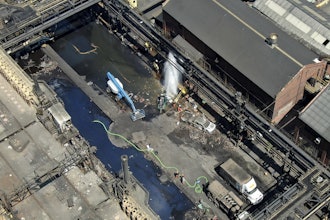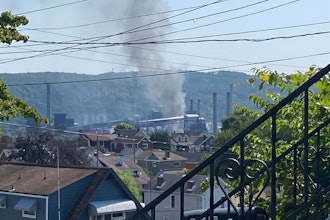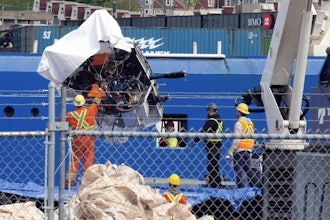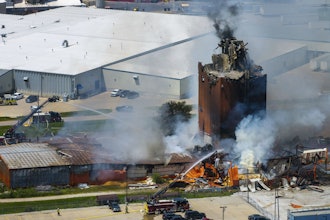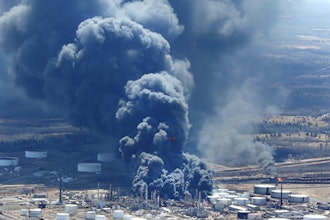www.newson-gale.com Page 1 of 5
W
h
it
e
P
a
p
e
r
For any person responsible for the safety of employees,
colleagues, plant equipment and plant property, one of the
most potentially confusing aspects of providing a safe
operating environment is trying to determine if that site’s
manufacturing or handling processes have the potential to
discharge static sparks into flammable or combustible
atmospheres.
Electrostatics is a detailed subject area that, for most of us,
appears to be a black art accessible only to academics and
experienced process safety consultants. Because static
ignition hazards occur at the “nuclear level”, it is naturally
difficult to visualise how and why static electricity is a hazard in
industries where flammable and combustible products are
regularly processed. There are so many variables that have a
role to play in electrostatics, it is almost impossible to predict
the net effects of these parameters, in a hazardous prevention
context, without feeling the need to conduct controlled
laboratory testing to determine if a specific process could
produce incendive electrostatic discharges.
If you consider that a walking across a carpet can generate
35,000 volts (35 KV) on a person, it is easy to see how normal
everyday processes can generate potentials well in excess of
10,000 volts (10 KV). For a small object like a metal bucket,
which has a typical capacitance of 20 pico-farads, the total
energy available for discharge at 10 KV is 1mJ. This is higher
than most flammable vapour minimum ignition energies
(MIE’s). Scaling up, the ignition energy available on a human,
at 10 KV, would be around 10mJ. In powder conveying
operations voltages of the order of 1000 KV can easily be
generated on parts of the conveying system. Tank trucks
undergoing loading can carry as much as 2000 mJ of ignition
energy.
It can be time-consuming, and expensive, to investigate and
determine the level of voltage that can arise as a result of these
charging mechanisms. Complicating matters further, ignitable
electrostatic discharges can occur in many forms ranging from
spark discharges, propagating brush discharges, bulking
brush discharges, to corona discharges. The effort required to
assess, determine and combine these variables into a
cohesive audit of a potential hazard is, by no means, easy.
Which standards should I follow to control static
electricity in ignitable atmospheres?
Fortunately, there are several internationally recognised
standards that provide guidance on ways to limit electrostatic
hazards enabling those responsible for worker health and
safety minimise the risk of incendive static discharges.
Hazardous area operators who can demonstrate compliance
with these standards will go a long way to providing a safe
working environment and preventing the ignition of ignitable
atmospheres. The most comprehensive standards are:
NFPA 77: Recommended Practice on Static Electricity (2007).
CENELEC CLC/TR 60079-32-1: “Explosive atmospheres -
Part 32-1: Electrostatic hazards, guidance” (2015).
API RP 2003: Protection against Ignitions Arising out of Static,
Lightning and Stray Currents (2008).
API RP 2219: Safe Operation of Vacuum Trucks in Petroleum
Service (2005).
The standards, particularly NFPA 77 and CLC/TR: 60079-32-1,
describe a range of processes where static charges can be
generated including flow in pipes and hoses; loading &
unloading of tank trucks; tank car loading & unloading; filling
and dispensing portable tanks, drums and containers; storage
tank filling and cleaning; mixing, blending and agitation
operations; the conveying of powders and other operations.
You don’t need to be a rocket scientist
to safeguard against the hazards
of static electricity.
Inquiry > Click here to submit a
product related query or a request
for quotation.
Author Details:
Mike O’Brien, Managing Director for Newson Gale
If you have any questions relating to the topics discussed
in this article, please contact .Newson Gale
www.newson-gale.com
The API RP 2003 standard focuses on tank truck loading and
tank car filling operations, storage tank filling and general
operations involving petroleum products. API RP 2219
provides detailed guidance on protecting vacuum trucks from
electrostatic hazards.
These standards outline what factors can be identified and
controlled to limit electrostatic hazards and these controls
typically depend on:
Preventing the accumulation of electrostatic charges on Ÿ
plant equipment, people and the material transferred.
Controlling the process to minimise the generation of Ÿ
electrostatic charges.
NFPA 77 (5.1.10) states that the transfer of just one electron in
500,000 atoms is required to generate voltages with enough
energy to ignite flammable atmospheres.
Effective grounding and bonding is presented in the standards
as the primary means of protection from electrostatic hazards
and is the most straight forward, secure and cost-effective
means of ensuring static hazards are managed and controlled
correctly. Eliminating the accumulation of static charges will
eliminate the static hazard.
Grounding and Bonding - What are the key
benchmarks?
The ground has an infinite capacity to absorb charges and
“grounding” (earthing) is the act of connecting a body to an
electrode (or other buried structure) that has a verified contact
resistance to the ground, typically less than 25 ohms.
Grounding provides a path for static charges to rapidly flow to
ground, reducing the voltage of the object to zero and thereby
eliminating the presence of an ignition source. “Bonding”
connects objects so that they are at the same electrical
potential preventing discharges when they are positioned in
close proximity to each other. If bonding is carried out, it is
important to ensure that one of the bonded objects is
connected to ground, thereby ensuring all parts of the bonded
system are at zero potential.
Static Hazard = Situation where the rate of charge
accumulation exceeds the rate of charge dissipation
Given that grounding is the primary source of static hazard
prevention it is important to understand what parameters can
be identified as providing a satisfactory level of protection. The
key to static hazard protection is ensuring that the path
between the charged object and ground is of a sufficient quality
to dissipate the static charges safely and rapidly.
The majority of plant equipment at risk of static charge
accumulation is made of metal. Metals are excellent
conductors and the natural resistive properties of metals
ranging from copper through to steel means that electrical
resistance to the transfer of charges from the body is low,
provided that the body has good contact with ground. If the
metal body is not grounded, this positive characteristic can
quickly become a negative as isolated metal conductors are
the primary source of static spark ignition hazards.
To illustrate, a 10 m length (32 feet) of 2 mm diameter steel
cable, in good condition, should have an overall resistance
approximating to 1.44 ohms over its entire length (see table
below).
The maximum value of resistance present in metal circuits,
which includes the body at risk of static charge accumulation,
should be equal to or less than 10 ohms and is the benchmark
value of resistance recommended by all four standards. If a
resistance of 10 ohms or more is detected then there is a
likelihood that the grounding circuit has been compromised
and should be checked for corrosion or breakages.
Page 2 of 5
You don’t need to be a rocket scientist
to safeguard against the hazards of static electricity.
Material Typical Volume Resistance to
Resistivity Charge Transfer
-8Copper 1.7 x 10 Ω.m Low
-7Steel 4.52 x 10 Ω.m Low
-8Carbon 10 x 10 Ω.m Low
10Glass 1 x 10 Ω.m High
15 22Polymers 10 to 10 Ω.m High
Resistivities of different material properties
www.newson-gale.com
The table above outlines the maximum resistance levels for
static dissipation circuits recommended by the standards for
static control in potentially ignitable atmospheres. It is
important to ensure that the static dissipative path, the path that
channels the charging current to ground, is 10 ohms or less,
and stays that way for the duration of the process.
How to Audit your processes for static hazards:
Figure 6.1.2 in NFPA 77 provides a decision tree flow chart
which helps define a simple and effective way to help decide
whether or not conductive objects should be grounded. It
shows that the first step in an audit is to determine if there “is
the potential to create an ignitable mixture”. If there is a
potential for this to occur the next step states “bond and
ground all conductive equipment”. There are further steps
that query whether or not “electrostatic energy” can be
generated and accumulate. As stated earlier, the process of
determining these factors can be time consuming and require
the expertise of process safety consultants. Very often, it is
more cost-effective to ground the object, particularly if it is
made of conductive metal, when it is known that materials with
different properties come into contact. In order to provide a
basic audit of processes NFPA 77 (Fig. 6.1.2) lists the following
scenarios where charge can be generated:
When the answer to these questions is “YES”, it states that the
potential MIE should be calculated to determine if it exceeds
the MIE of the atmosphere present. This will probably be the
hardest thing to calculate so the best advice is to ground the
equipment as there may not be an opportunity to change the
material being processed or the equipment, through which it is
pumped, conveyed or handled.
What do the standards recommend for specific
applications?
Tank Trucks: NFPA 77, CLC/TR: 60079-32-1 and API RP 2003
recommend that the first procedure in tank truck material
transfer operations is to ground the tanker prior to any other
operation being carried out by the driver. Interlocking static
grounding systems, with ground status indicators, should also
be specified so that if the tank truck is not protected from static
discharges due to incorrect grounding, the system will not
permit the flow of product thereby eliminating the generation of
electrostatic charges. The static grounding system should
monitor the resistance in the grounding circuit ensuring it does
not rise above 10 ohms. CLC/TR: 60079-32-1 specifies 10 ohms
or 100 ohms as being suitable for convenience in monitoring,
however 10 ohms would be the established standard for large
companies with a good track record in static control safety.
Grounding of tank truck is critical to ensuring static charges
do not accumulate on the tank body.
Page 3 of 5
Can charge generate?
Does process include:
• Flow of material?
• Agitation or atomization?
• Powders or solids?
• Interaction with personnel?
• Filtration?
• Settling?
• Bubbles rising?
If YES, can charge accumulate?
Does process include:
• Insulated equipment?
• Insulating materials?
• Isolated conductive equipment?
• Interaction with personnel?
• Nonconductive liquids?
• Mists or clouds?
2mm diameter 25 metres 10 metres 5 metres
cable (82 feet) (32 feet) (16 feet)
Copper 0.13 ohms 0.05 ohms 0.027 ohm
Steel 3.6 ohms 1.44 ohms 0.72 ohms
NFPA 77 API 2003 API 2219 CLCTR 50404
Metal 10 ohms 10 ohms 10 ohms 10 or 100 ohms
Circuits
8Type ‘C’ must be no no 1 x 10 ohms
FIBC grounded reference reference
Resistance values recommended by the standards
for static grounding and bonding circuits
Resistance values for a range of cable lengths
You don’t need to be a rocket scientist
to safeguard against the hazards of static electricity.
www.newson-gale.com
Tank Cars: API RP 2003 and NFPA 77 identify parts of the tank
car that could become isolated from the railway tracks. Non-
conductive wear pads and bearings can be located between
the barrel and the chassis and it is recommended that the barrel
is grounded prior to and during, the material transfer process.
This will prevent the accumulation of static charges on the
barrel and eliminate the risk of discharges from the barrel to the
fill pipe, and discharges to people or other grounded bodies.
NFPA 77 (8.8.2) states:
“Many tank cars are equipped with nonconductive bearings and
nonconductive wear pads located between the car itself and the
trucks (wheel assemblies)….. Therefore, bonding of the tank
car body to the fill system piping is necessary to protect against
charge accumulation”.
Vacuum Trucks: API 2219 provides guidance on the protection
of vacuum trucks when they are used to suck up flammable or
combustible products. Examples include waste collection
during storage tank cleaning operations and the suction of
combustible powders from dust collection chambers. Of the
many recommendations outlined in API 2219, the most relevant
instruction is to fully ground the truck by connecting it to “a
designated, proven ground source”, before commencing with
transfer operations. The “ground source” describes an object
with a low resistance connection to ground (earth). The standard
also states the importance of confirming that the connection
resistance between the truck and the designated grounding
point is less than 10 ohms and that this resistance should be
verified with the use of an ohm meter (or some other type of
measurement device).
People: As highlighted earlier, people, through regular
movement, can generate large potential differences on their
bodies and the accumulation of static charges should be
minimised so that operators do not discharge sparks in the
presence of ignitable atmospheres. The advice in the standards
is to ensure hazardous area floors are conductive and that
operator’s working in these areas should be wearing static
dissipative shoes to prevent charge accumulation on their body.
CLC/TR: 60079-32-1 states the shoes should be tested prior to
entry into the zoned (classified) area:
“All personnel should be earthed by means of conducting floors
and footwear (see 9.2 and 9.3). A personnel resistance monitor
should be installed at every entrance to any area where such
footwear is required.”
Portable containers: When portable metal containers like IBCs
and drums are being filled or dispensed from the advice in all
standards is to ground and bond all of the filling system and the
receiving vessels. NFPA 77 (8.13.3.2) states that:
“Bonding should be done with a clamp that has hardened steel
points that will penetrate paint, corrosion products, and
accumulated material using either screw force or a strong spring.”
There is some guidance in the standards regarding the use of
plastic lined metal containers. NFPA 77 states that a metal
container, with a plastic of lining of 2mm, or less, can be treated as
a metal drum. CLC/TR: 60079-32-1 contains a table with the
maximum recommended lining thicknesses and emphasises the
importance of ensuring that their interaction with conductive
objects does not promote high energy propagating brush
discharges. In general, filling insulating plastic containers is not
recommended. If a conductive liquid is being processed it may be
possible to dissipate charges using a conductive dip tube,
however, the use of dip tubes carry extra precautionary measures.
FIBCs: CLC/TR: 60079-32-1 provides the clearest guidance in
respect of resistance values that should be maintained when filling
or discharging from FIBC Type C bags. NFPA 77 states that the
bag should be grounded but does not specify a maximum
resistance value. CLC/TR: 60079-32-1 states:
“The conductive fabric and the conductive threads or filaments
shall have a resistance of the earthing point on the FIBC of less
8than (1 x) 10 Ω.”
Type D bags are designed to dissipate charges from bags
through “low energy” corona discharges. The potential drawback,
however, is that the bag could induce charges on surrounding
conductive objects. CLC/TR: 60079-32-1 states:
“any conductive items that may not normally be earthed (e.g.
drums on pallets) should either be earthed or removed from the
vicinity of the FIBC Type D. In addition, conductive items (e.g.
working tools, bolts and clips) shall not be placed or stored on the
FIBC.”
Page 4 of 5
You don’t need to be a rocket scientist
to safeguard against the hazards of static electricity.
N
G
U
S
W
h
it
e
P
a
p
e
r
2
1
0
7
0
9
1
8
Summary
Identifying and controlling electrostatic hazards can be a
challenging process for those of us responsible for ensuring
our colleagues, employees, equipment and property are fully
protected from electrostatic ignition hazards. There are many
factors that can contribute to the presence of a static hazard
but if the examples of grounding and bonding protection
outlined above can be followed, the majority of processes at
risk of static discharge will be controlled and accounted for.
When an audit of a process or procedure has identified an
electrostatic ignition hazard, it is important to specify
grounding and bonding systems that can demonstrate
compliance with the standards. Where possible, static
grounding instruments that can demonstrate resistance levels
recommended by the standards will ensure companies are
protected from this ever-present and hazardous ignition
source.
You don’t need to be a rocket scientist
to safeguard against the hazards of static electricity.
www.newson-gale.com
United Kingdom
Newson Gale Ltd
Omega House
Private Road 8
Colwick, Nottingham
NG4 2JX, UK
+44 (0)115 940 7500
[email protected]
Deutschland
IEP Technologies GmbH
Kaiserswerther Str. 85C
40878 Ratingen
Germany
+49 (0)2102 5889 0
[email protected]
South East Asia
Newson Gale S.E.A. Pte Ltd
136 Joo Seng Road, #03-01
Singapore
368360
+65 6704 9461
[email protected]
United States
IEP Technologies, LLC
417-1 South Street
Marlborough, MA 01752
USA
+1 732 961 7610
[email protected]
You don’t need to be a rocket scientist to safeguard against the hazards of static electricity.
For any person responsible for the safety of employees, colleagues, plant equipment and plant property, one of the most potentially confusing aspects of providing a safe operating environment is trying to determine if that site’s manufacturing or handling processes have the potential to discharge static sparks into flammable or combustible atmospheres.. Electrostatics is a detailed subject area that, for most of us, appears to be a black art accessible only to academics and experienced process safety consultants. Because static ignition hazards occur at the “nuclear level”, it is naturally difficult to visualise how and why static electricity is a hazard in industries where flammable and combustible products are regularly processed.
Latest in Safety











